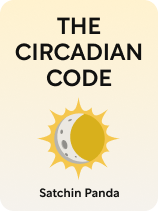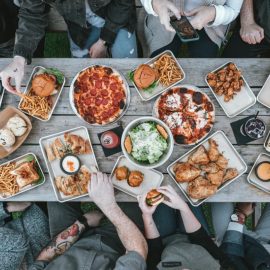

This article is an excerpt from the Shortform book guide to "The Circadian Code" by Satchin Panda. Shortform has the world's best summaries and analyses of books you should be reading.
Like this article? Sign up for a free trial here.
Is it hard for you to maintain a healthy weight despite watching what you eat? Could the timing of your meals be just as important as their content?
Satchin Panda’s time-restricted eating approach offers a fresh perspective on nutrition and weight management. This method focuses on when you eat rather than just what you consume. It suggests confining all meals and snacks to a specific window each day.
Read more to discover how this simple change could transform your health and well-being.
Satchin Panda on Time-Restricted Eating
According to Satchin Panda, time-restricted eating benefits your circadian rhythm. He recommends that you consume all your food within a 12-hour or shorter window each day. Eating within a set window allows your digestive system to take a break. This rest period gives your body time to repair damaged gut cells, which reduces inflammation and improves your overall health.
Panda elaborates that when you eat is just as important, if not more, than what you eat. In one of his studies, Panda fed mice the same diet rich in fat and sugar, but he varied their feeding times. The group of mice that ate all their food within a set eight- to 12-hour window each day maintained their weight and had healthy blood sugar and cholesterol levels. However, the group that ate freely throughout the day showed signs of poor health, despite having the same diet as the other mice.
(Shortform note: Some research on humans suggests that TRE doesn’t make much of a difference when it comes to weight loss and health. In one study, researchers divided participants into two groups: one that only restricted calories, and another that both restricted calories and limited eating to an 8-hour window. After a year, both groups showed similar weight loss and improvements in body fat percentage, cholesterol, blood pressure, and blood sugar. This suggests that calorie restriction, rather than the timing of meals, was the key factor in these results.)
If you’d like to implement TRE, Panda suggests starting with a 12-hour eating window each day, beginning with breakfast and ending with dinner—such as 8:00 a.m. to 8:00 p.m. Gradually reduce the window by an hour per week until you’re eating within a span of eight to 11 hours. The benefits of TRE grow for every hour you reduce your eating window, but it’s okay to go back to an 11- to 12-hour window once you’ve achieved your desired weight and want to maintain it.
Keep in mind that consuming anything other than water counts as eating—including coffee, alcohol, and snacks. Over time, you should naturally feel less hungry after dinner and crave fewer unhealthy foods
(Shortform note: In Fast. Feast. Repeat., Gin Stephens recommends a similar approach to starting TRE, adding that you should commit to a four-week period during which you adapt to this new way of eating by gradually reducing your eating window. She recommends you keep your diet the same to avoid overwhelming your body with changes. Your body needs anywhere from three to eight weeks to adapt, so you may experience tiredness and headaches as your body gets used to TRE. However, you’ll experience fewer cravings once your body learns to access fat for energy.)
Stop Late-Night Eating
A second habit Panda suggests you adopt is to avoid eating anything two to four hours before bedtime. Your body shifts its focus from digestion to rest and repair after your last meal of the day so it can work on important tasks during sleep—like repairing damaged cells and growing healthy gut bacteria. So, if you eat after this shift happens, you interrupt your digestive system’s healing time and force it to process food when it isn’t prepared to do so.
(Shortform note: Many dietitians echo Panda’s advice to avoid eating a few hours before bed, but life doesn’t always allow for perfect timing. If you do need to eat something late at night, some dietitians say that raw or steamed vegetables are the best choice. Because these have fewer calories than high-fat, sugary foods like ice cream or cookies, they’re less likely to disrupt your metabolism. However, if you’re craving something sweet, Greek yogurt, a small piece of fruit with dark chocolate, or an apple with peanut butter are good options that have protein and healthy fats, and will satisfy your hunger without overloading your digestive system.)
Panda writes that eating when your digestive system isn’t prepared to process food can lead to indigestion and weight gain. Let’s explore why.
Indigestion
First, eating late causes indigestion because the gut muscles that push food through your intestines are less active at night, meaning food moves slower through your digestive tract. Additionally, when you’re standing or sitting during the day, gravity helps pull food downward through your digestive system. However, when you’re lying down to sleep, this gravitational effect is reduced, slowing digestion. Panda adds that at night, your body makes more stomach acid and less saliva to balance it out, which can make acid reflux worse if you eat late.
(Shortform note: Although your gut muscles might not work efficiently when you’re lying down to sleep, the motion of your esophagus is unaffected by gravity. In Gut, Giulia Enders explains that as food travels down your esophagus, it’s propelled by muscles in a wave-like motion called peristalsis. This process is so effective that you can move food to your stomach even while standing on your head.)
Weight Gain
Second, Panda writes that late-night eating causes weight gain because it disrupts your body’s natural fat-burning process. He explains that your body typically starts to burn fat only a few hours after you’ve last eaten. When you eat late at night, you reset this timer, preventing your body from entering this fat-burning mode. If you regularly eat late, you repeatedly interrupt this process, which can lead to weight gain and related health issues like insulin resistance.
| Your Set Weight Affects How Much Fat Your Body Stores Panda talks about when your body starts to burn fat, but he doesn’t explain in detail how this process works. In The Obesity Code, Jason Fung explains that your body’s set weight—the default amount of fat your body tries to maintain—influences the amount of fat your body stores. If you have less fat than your set weight, your body will store more calories as fat. If you have more fat than your set weight, your metabolism speeds up to burn off the excess fat. However, chronically high insulin levels can disrupt this balance by raising your set weight. When this happens, your body “thinks” it needs more fat, even if you’re already overweight. As a result, your metabolism slows down, you feel less satisfied after eating, and you experience increased hunger. These changes make it difficult to lose weight and easy to gain it. |
Exercise
Think about your typical meal routine. What time do you usually eat your first and last meals of the day? Does your meal schedule align with Panda’s recommendation of a 12-hour or shorter eating window?

———End of Preview———
Like what you just read? Read the rest of the world's best book summary and analysis of Satchin Panda's "The Circadian Code" at Shortform.
Here's what you'll find in our full The Circadian Code summary:
- The modern habits that disrupt your circadian rhythm
- How your internal 24-hour schedule works
- The little habits that will recharge your battery






